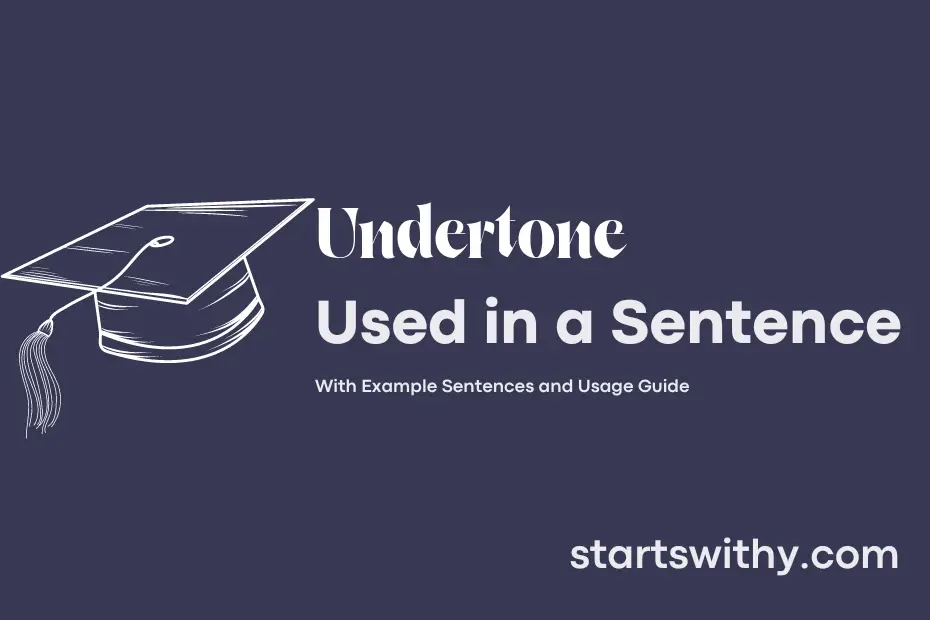Ever noticed a subtle message embedded within a conversation or piece of writing? This underlying tone, known as an undertone, adds depth and nuance to the overall meaning.
An undertone is a subtle, indirect hint or suggestion that conveys additional meaning beyond the surface level. It can shape the mood or implications of a statement without being explicitly stated, often requiring a keen ear or eye to detect.
7 Examples Of Undertone Used In a Sentence For Kids
- Undertone is the hidden feeling in a story.
- Sometimes a smile can have a undertone of sadness.
- The music had a mysterious undertone that made us shiver.
- When someone whispers, it can have a secretive undertone.
- The painting had a peaceful undertone that made us feel calm.
- A joke can have a playful undertone that makes us laugh.
- The rainy day had a gloomy undertone that made us feel sad.
14 Sentences with Undertone Examples
- Undertone of excitement filled the lecture hall as the professor announced a surprise quiz.
- Students whispered among themselves, their voices carrying a tense undertone during the final exam.
- The undertone of competition was palpable during the inter-university sports tournament.
- An undertone of disillusionment could be felt among the students after the cancellation of the annual college fest.
- Despite the cheerful facade, there was a subtle undertone of stress among the students preparing for placement interviews.
- The seminar had an energizing undertone that encouraged students to actively participate in discussions.
- The undertone of camaraderie among classmates made group projects more enjoyable and productive.
- The farewell party had a bittersweet undertone as seniors bid adieu to their college life and friends.
- The professor’s words had an inspiring undertone that motivated students to strive for excellence in their studies.
- A hint of skepticism lingered in the undertone of conversations about the credibility of online classes.
- A sense of urgency underscored the undertone of discussions about upcoming deadlines for assignments and projects.
- There was a playful undertone to the friendly banter between college friends during a study break.
- The undertone of curiosity in the room prompted students to ask thought-provoking questions during guest lectures.
- An undertone of disappointment was evident in the reactions of students upon hearing about the postponement of the annual fest.
How To Use Undertone in Sentences?
Undertone is a term used to describe the underlying mood or tone in a piece of writing or conversation. When you want to use “undertone” in a sentence, here are some tips to keep in mind:
-
Choose the right context: Undertone is often used when discussing subtle emotions or attitudes that are not explicitly stated. Make sure the sentence you are crafting fits this idea.
-
Identify the underlying feeling: Before using undertone in a sentence, try to understand the hidden emotions or meanings behind the words being spoken or written.
-
Use it appropriately: Insert undertone in a sentence where it can highlight the unspoken subtleties or nuances within the communication.
-
Consider the impact: Undertone can add depth and complexity to your sentences by conveying a secondary layer of meaning. Ensure that its usage enhances the overall message you are trying to convey.
For example:
– “Her sarcastic undertone made it clear that she was not happy with the decision.”
– “The poetry had a melancholic undertone that resonated with the audience.”
By following these guidelines, you can effectively incorporate undertone into your sentences and enhance your communication skills.
Conclusion
In conclusion, sentences with undertones often convey subtle implications or emotions beyond their literal meaning. These nuances can significantly impact how a message is interpreted by the reader or listener. By carefully crafting sentences with undertones, writers and speakers can add depth and complexity to their communication, allowing them to convey layers of meaning and evoke specific reactions.
Whether it’s a hint of sarcasm, a touch of irony, or a hint of dissatisfaction, sentences with undertones can be powerful tools for conveying messages effectively. Paying attention to the undertones in communication can enhance understanding and help avoid misunderstandings, making it important to be mindful of the subtle cues embedded within language for more effective and impactful communication.



